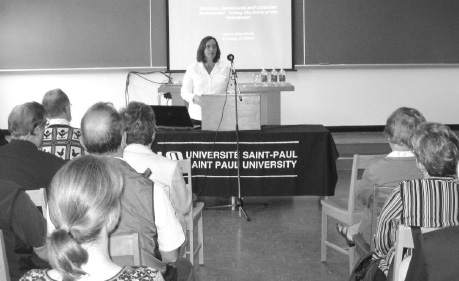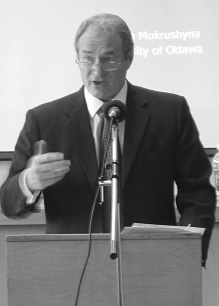The New Pathway: One of the
First to Report on Holodomor
Paul Migus, President,UNF Ottawa-Gatineau
 The Ukrainian Canadian
community in Ottawa, Ont. and Gatineau, Que. participated in the Ukrainian
National Federation’s first public event organized by its newly-revived branch,
featuring Dr. Halyna Mokrushyna’s
presentation of “Ukrainian Sentiments and Canadian Sustenance: Telling the
Story of the Holodomor”. Co-sponsored by
the Metropolitan Andrey Sheptytsky Institute of Eastern Christian Studies and
the UNF Ottawa-Gatineau Branch, the public lecture was held at Saint
Paul University
on May 25, 2011,
attended by almost 50 members of the community.
All participants thoroughly enjoyed Dr. Mokrushyna’s enlightening presentation
of her MA thesis (University
of Ottawa)
which explored the campaigns in Canada
to raise awareness and recognition of the Holodomor.
The Ukrainian Canadian
community in Ottawa, Ont. and Gatineau, Que. participated in the Ukrainian
National Federation’s first public event organized by its newly-revived branch,
featuring Dr. Halyna Mokrushyna’s
presentation of “Ukrainian Sentiments and Canadian Sustenance: Telling the
Story of the Holodomor”. Co-sponsored by
the Metropolitan Andrey Sheptytsky Institute of Eastern Christian Studies and
the UNF Ottawa-Gatineau Branch, the public lecture was held at Saint
Paul University
on May 25, 2011,
attended by almost 50 members of the community.
All participants thoroughly enjoyed Dr. Mokrushyna’s enlightening presentation
of her MA thesis (University
of Ottawa)
which explored the campaigns in Canada
to raise awareness and recognition of the Holodomor.
The Holodomor, (based on
two Ukrainian words: holod - ‘hunger, starvation, famine,’ and moryty - ‘to
induce suffering, to kill’), was an act of genocide against the Ukrainian
people committed by the Soviet Communist regime in 1932-33. In the very heart
of Europe - a region
considered Europe’s
breadbasket - Stalin’s Communist regime committed a horrendous act of genocide
against up to 10 million Ukrainians. An ancient nation of agriculturists was
subjected to starvation, one of the most ruthless forms of torture and death.
The government imposed exorbitant grain quotas, in some cases confiscating
supplies down to the last seed. The territory
of Soviet Ukraine
and the predominantly Ukrainian-populated Kuban
region of Northern Caucasus
(Soviet Russia) were isolated by armed units, so that people could not go in
search of food in neighbouring Soviet regions, where it was more readily
available. The result was the Ukrainian Great Famine Genocide of 1932-33, known
in Ukrainian as the Holodomor, or extermination by artificial famine.
Almost
80 years ago, one of the first newspapers in Canada,
and the world, which reported on the Holodomor in Ukraine
in 1932 was The New Pathway Ukrainian Weekly (affiliated with the Ukrainian
National Federation). Dr. Mokryshyna
provided an excellent overview of her research dissertation which captured the
3 stages of the Holodomor Awareness Campaign.
Stage
one focused on the period 1930-1970; namely getting the very fact recognized
that the Great Famine really took place.
In the early years, Ukrainian Canadian media, such as Novyj Shliakh (The
New Pathway) and Holos Ukrainy, and Ukrainian Canadian organizations publicized
knowledge about the famine-induced genocide.
Later in this period, various Chairs of Ukrainian Studies at Canadian
universities undertook primary research into the history of Ukraine.
The
second stage, during the 1980s, brought the Great Famine to world-wide
attention and provided evidence that this famine was premeditated and carried
out by Stalin’s regime with the purpose of exterminating Ukrainians. This
decade saw the introduction of academic research and use of mass media, such
the 1984 film ‘Harvest of Despair’, and the 1986 book ‘Harvest of Sorrow’ to
substantiate the genocide; notwithstanding continued Soviet denials of any
atrocities.
 The
third stage, between 1980 and 2010, was the realization of the Holodomor’s
“official recognition” as genocide. With strong support from the Ukrainian
Canadian community, this period focused on the Government of Canada’s
leadership role in providing official government recognition of the Holodomor
as an act of genocide against Ukrainians.
The major events in Ukrainian Canadian engagement in Canada’s
political arenas witnessed a successful Senate of Canada Resolution in 2003 on
the Ukrainian Famine. In 2008, MP James Bezan introduced a private member’s
bill – Bill C-459 - Ukrainian Famine and Genocide (Holodomor): a Memorial Day
Act, which was passed unanimously by all parliamentary parties. In addition, after dedicated advocacy by the
Ukrainian Canadian community at the provincial level, similar Holodomor
awareness and recognition legislation was passed by provincial legislatures in
Saskatchewan (2008), Manitoba (2008), Alberta (2008), Ontario (2009), and
Quebec (2010). Efforts are still pending
in British Columbia.
The
third stage, between 1980 and 2010, was the realization of the Holodomor’s
“official recognition” as genocide. With strong support from the Ukrainian
Canadian community, this period focused on the Government of Canada’s
leadership role in providing official government recognition of the Holodomor
as an act of genocide against Ukrainians.
The major events in Ukrainian Canadian engagement in Canada’s
political arenas witnessed a successful Senate of Canada Resolution in 2003 on
the Ukrainian Famine. In 2008, MP James Bezan introduced a private member’s
bill – Bill C-459 - Ukrainian Famine and Genocide (Holodomor): a Memorial Day
Act, which was passed unanimously by all parliamentary parties. In addition, after dedicated advocacy by the
Ukrainian Canadian community at the provincial level, similar Holodomor
awareness and recognition legislation was passed by provincial legislatures in
Saskatchewan (2008), Manitoba (2008), Alberta (2008), Ontario (2009), and
Quebec (2010). Efforts are still pending
in British Columbia.
Other
than in Quebec,
members of parliament and legislative assemblies of Ukrainian ancestry were the
primary sponsors of the Holodomor legislation. In addition to the federal
government, four Canadian provinces have also recognized the Holodomor
proclaiming the fourth Saturday of each November as Holodomor Remembrance Day
in Canada. The framing of the Canadian legislation
focused not only on the genocide against Ukrainians, but also the Soviet crimes
against humanity and the violation of basic human rights.
The
Ukrainian Canadian community has also been successful in promoting the
recognition and awareness of the Holodomor through the provincial school
systems. In Alberta
and Manitoba,
the Holodomor is a compulsory subject on the academic curriculum. While in the provinces of Saskatchewan
and Ontario,
it is offered on a voluntary basis by various school boards. In addition, the Ukrainian Canadian Research
and Documentation Centre (UCRDC) was established in Toronto,
and provides 164 documented oral histories by survivors and witnesses of the
Ukrainian artificial famine of 1932-1933.
These can be accessed at www.holodomorsurvivors.ca
Dr.
Mokrushyna also noted that while ‘national’ feelings are often associated with
negative social attributes, the Ukrainian Canadian experience in rallying
around the Holodomor has had and continues to have a positive role. The Ukrainian Canadian community has
constantly acted as the guardians of this Ukrainian cultural memory. This is
all the more significant given that the Holodomor was not recognized in Soviet
Ukraine, and in current day Ukraine, the recognition of the Holodomor as an act
of genocide continues to be in dispute.
PHOTOS
1 - Dr.
Halyna Mokrushyna at Saint
Paul University, Ottawa, presented findings on Canadian awareness
of the Holodomor
2 - Paul
Migus, President, UNF Ottawa-Gatineau Branch
 The Ukrainian Canadian
community in Ottawa, Ont. and Gatineau, Que. participated in the Ukrainian
National Federation’s first public event organized by its newly-revived branch,
featuring Dr. Halyna Mokrushyna’s
presentation of “Ukrainian Sentiments and Canadian Sustenance: Telling the
Story of the Holodomor”. Co-sponsored by
the Metropolitan Andrey Sheptytsky Institute of Eastern Christian Studies and
the UNF Ottawa-Gatineau Branch, the public lecture was held at
The Ukrainian Canadian
community in Ottawa, Ont. and Gatineau, Que. participated in the Ukrainian
National Federation’s first public event organized by its newly-revived branch,
featuring Dr. Halyna Mokrushyna’s
presentation of “Ukrainian Sentiments and Canadian Sustenance: Telling the
Story of the Holodomor”. Co-sponsored by
the Metropolitan Andrey Sheptytsky Institute of Eastern Christian Studies and
the UNF Ottawa-Gatineau Branch, the public lecture was held at  The
third stage, between 1980 and 2010, was the realization of the Holodomor’s
“official recognition” as genocide. With strong support from the Ukrainian
Canadian community, this period focused on the Government of Canada’s
leadership role in providing official government recognition of the Holodomor
as an act of genocide against Ukrainians.
The
third stage, between 1980 and 2010, was the realization of the Holodomor’s
“official recognition” as genocide. With strong support from the Ukrainian
Canadian community, this period focused on the Government of Canada’s
leadership role in providing official government recognition of the Holodomor
as an act of genocide against Ukrainians.